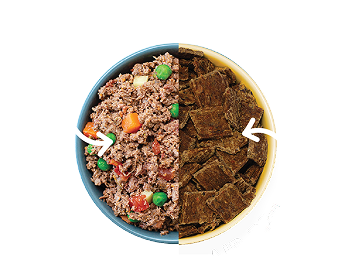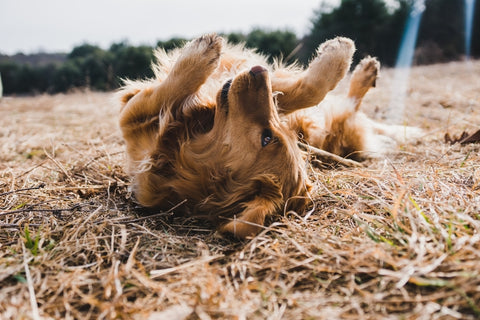
What’s the deal with the guaranteed analysis of dog food?

When you’re trying to eat healthy as a human, you probably read labels to find out what’s in the foods you eat. You’re looking for good nutrition from clean ingredient lists filled with things you recognize and can pronounce. Right?
Reading the label is a best practice when you want to make sure your dog is eating healthy, too. But it can get a little tricky.
Guaranteed analysis is the pet food industry equivalent of the nutrition panel you see on human food packaging. Unfortunately, guaranteed analysis is not so easy to understand. Here is a rundown on how to make sense of it.
What is Guaranteed Analysis?
Federal and state pet food regulations mandate guaranteed analysis for pet foods. It means that all pet food labels must state guarantees for the minimum levels of crude protein and crude fat, plus the maximum percentages of crude fiber and moisture in the food.
This becomes a “nutrient guarantee” consumers can trust. The food has been tested to confirm that the nutrition claimed on the label is present in the final product. Note that the term “crude” refers to the method of testing the food, not to the quality of the nutrient itself.
Why moisture causes confusion
Guaranteed analysis can create confusion for dog owners who want to compare nutrition levels between very different types of dog food, like dry kibble vs. moist pet foods. That’s because testing is done on an “as fed” basis — the food is tested as it comes, straight out of the bag or can.
Compare the guaranteed analysis between dry and moist pet food products — whether they are raw, gently cooked or canned — and you’ll notice that crude protein and most other nutrient levels will show up much lower for the moist product.
This isn’t because the moist product is less nutritious. It’s because moist foods typically have 65 to 78% moisture, while dry pet foods have just 10 to 12%. To make meaningful comparisons of guaranteed analysis nutrient levels between a moist and dry dog food, they need to be compared on the same moisture basis.
Luckily for you, you can convert the guarantees for both products to a dry matter basis. It’s easy!
How to convert to a dry matter basis
To convert a nutrient guarantee to a dry matter basis, simply divide the percent guarantee by the percentage of dry matter, then multiply by 100. Here’s an example:
Say a moist pet food guarantees 12% crude protein, and has 75% moisture. That means it has 25% dry matter. When you divide the moist food’s 12% crude protein by its 25% dry matter and multiply by 100, you find out that it has 48% crude protein on a dry matter basis.
Meanwhile, a dry pet food contains 27% crude protein, and has 10% moisture. That means it has 90% dry matter. The same calculation means you divide the dry food’s 27% crude protein by its 90% dry matter and multiply by 100, you find out that it has 30% crude protein on a dry matter basis.
Wow! Though it may appear that the dry pet food has a higher guaranteed analysis protein content, it’s actually the moist food that wins out.
Ok, but is there an easier way?
Is there an easy way to figure this out without a calculator, you ask? Sure. A simple way to compare is to remember that the amount of dry matter in a dry food is about four times the amount in a moist product.
Knowing this, you can compare guarantees between a dry and moist food by simply multiplying the moist food guarantee by four. Then compare it to the dry product’s guarantee.
Don’t forget to check the carbs
Once you start getting empowered with label reading, of course you’d like to figure out how to check your dog’s carb levels — controlling carbs is one way to keep your dog from a top health problem: being overweight.
The tricky thing about determining a pet food’s carbohydrate level is that the Association of American Feed Control Officials (AAFCO) does not require carbohydrate percentages to be listed on a pet food label. I know, right?
Again, easy math can help you determine how carb-heavy any dog food really is.
Starting with 100%, simply subtract the percentage of protein, fat, moisture, and ash noted on the label. If ash isn’t listed, you can assume 6% for most dog foods. If you’re comparing with A Pup Above’s fresh formulas, they use closer to 1% ash.
What you want to see is carb levels not exceeding 20-25%. Any higher is considered “high carb” for dogs, and can lead to weight gain from blood sugar fluctuations.
When you do the math, you’ll find that many dry formulas are loaded with carbs — like in the realm of 40 to 50% carbs! Higher quality dry and moist foods will show up in the 35% carbohydrate level.
Dry pet food gets carb heavy quickly partly because kibble needs starches to bind it. Even canned food will have gums or harmful gelling agents like carrageenan — which has been linked to ulcers and inflammation — to solidify the food.
Such a high amount of carbs can lead to insulin resistance, obesity, diabetes and other health problems in dogs. Aside from these health problems, studies have found that feeding dogs to maintain a lean body weight can increase life span by almost 2 years. That’s huge!
When you do the math on high quality fresh, whole dog food, you should find less than 15% carbohydrates. A Pup Above’s recipes are only 4 to 5% carbohydrates, which makes them great low-carb choices.
Be sure to compare apples to apples
The guaranteed analysis can help you look into exactly what you choose to feed your beloved pup, but only if you take the time to compare apples to apples. And by that, we mean comparing on a dry matter basis.
Don’t be fooled at first glance into thinking that dry food is more nutritious for your dog — often, the truth is completely the opposite. Plus, knowing how loaded with carbs dry and traditional canned foods can be, be sure to check them as well. Fresh, whole foods like A Pup Above offer high nutrition, low carb formulas with a tasty, natural gravy your dog will love to eat.
Whatever dog food product you choose, it pays to be aware of label complexities. All it takes is a little ingenuity and quick calculation to be sure you’re getting a clear picture of your pet’s food.
Top Stories

Why Do Dogs Lick Their Paws?

Why Do Dogs Whimper & Make Noises in Their Sleep?

Healthy Vet-Approved Homemade Dog Food Recipes

How To Cook Sweet Potatoes for Dogs






















